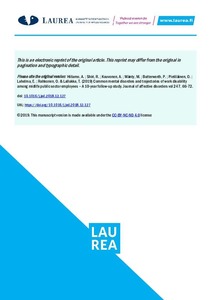Common mental disorders and trajectories of work disability among midlife public sector employees : a 10-year follow-up study
Hiilamo, Aapo; Shiri, Rahman; Kouvonen, Anne; Mänty, Minna; Butterworth, Peter; Pietiläinen, Olli; Lahelma, Eero; Rahkonen, Ossi; Lallukka, Tea (2019)
Avaa tiedosto
Lataukset:
Hiilamo, Aapo
Shiri, Rahman
Kouvonen, Anne
Mänty, Minna
Butterworth, Peter
Pietiläinen, Olli
Lahelma, Eero
Rahkonen, Ossi
Lallukka, Tea
Elsevier
2019
CC-BY-NC-ND 4.0
Julkaisun pysyvä osoite on
https://urn.fi/URN:NBN:fi:amk-201901231512
https://urn.fi/URN:NBN:fi:amk-201901231512
Tiivistelmä
Abstract
Objective
We examined trajectories of work disability, indicated by sickness absence and disability retirement, among midlife public sector employees with and without common mental disorders (CMD) at baseline. We also examined adverse childhood events, occupational class, long-standing illness and health behaviour as determinants of the trajectories.
Methods
A sample from the Helsinki Health Study was extracted comprising 2350 employees. Baseline characteristics were obtained from mail surveys conducted in 2000–2 and 2007. CMD were measured by the General Health Questionnaire. Participants were followed between the ages of 50–59. Work disability trajectories were modelled by the annual number of work disability months in group-based trajectory analysis. Multinomial regression was used to predict trajectory group memberships.
Results
Three trajectories were identified: no work disability (consisting 59% of the all employees), stable/low (31%) and high/increasing disability (10%). Employees with CMD were more likely to belong to the stable/low (odds ratio 1.73 [95% confidence interval 1.37–2.18]), and the high/increasing (2.55 [1.81–3.59]) trajectories. Stratified models showed that the determinants of the trajectories were largely similar for those with CMD compared to those without CMD except that obesity was a somewhat stronger predictor of the high/increasing trajectory among employees with CMD.
Limitations
The focus on midlife public sector employees limits the generalisability to other employment sectors and younger employees.
Conclusions
CMD were strongly associated with a trajectory leading to early exit from employment and a stable/low work disability trajectory. These findings have implications for interventions promoting work ability of employees with mental ill-health.
Objective
We examined trajectories of work disability, indicated by sickness absence and disability retirement, among midlife public sector employees with and without common mental disorders (CMD) at baseline. We also examined adverse childhood events, occupational class, long-standing illness and health behaviour as determinants of the trajectories.
Methods
A sample from the Helsinki Health Study was extracted comprising 2350 employees. Baseline characteristics were obtained from mail surveys conducted in 2000–2 and 2007. CMD were measured by the General Health Questionnaire. Participants were followed between the ages of 50–59. Work disability trajectories were modelled by the annual number of work disability months in group-based trajectory analysis. Multinomial regression was used to predict trajectory group memberships.
Results
Three trajectories were identified: no work disability (consisting 59% of the all employees), stable/low (31%) and high/increasing disability (10%). Employees with CMD were more likely to belong to the stable/low (odds ratio 1.73 [95% confidence interval 1.37–2.18]), and the high/increasing (2.55 [1.81–3.59]) trajectories. Stratified models showed that the determinants of the trajectories were largely similar for those with CMD compared to those without CMD except that obesity was a somewhat stronger predictor of the high/increasing trajectory among employees with CMD.
Limitations
The focus on midlife public sector employees limits the generalisability to other employment sectors and younger employees.
Conclusions
CMD were strongly associated with a trajectory leading to early exit from employment and a stable/low work disability trajectory. These findings have implications for interventions promoting work ability of employees with mental ill-health.
